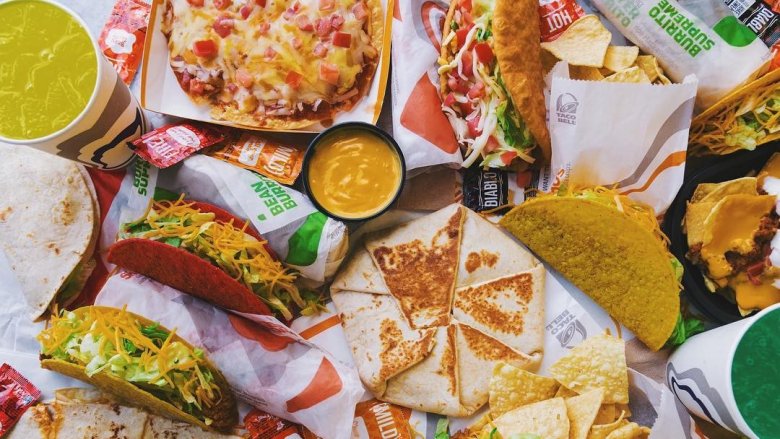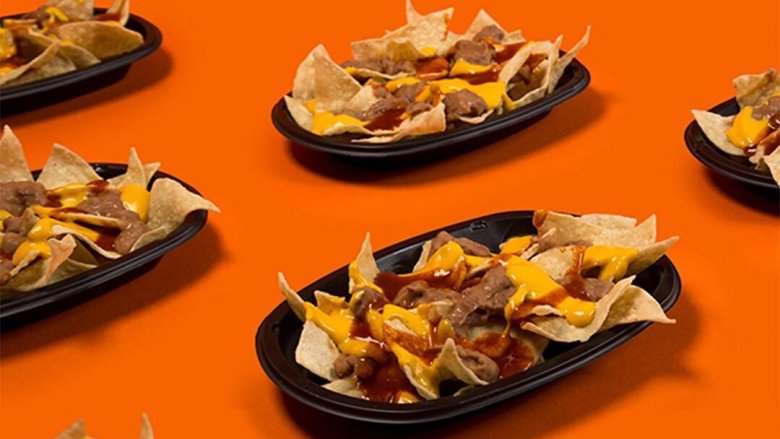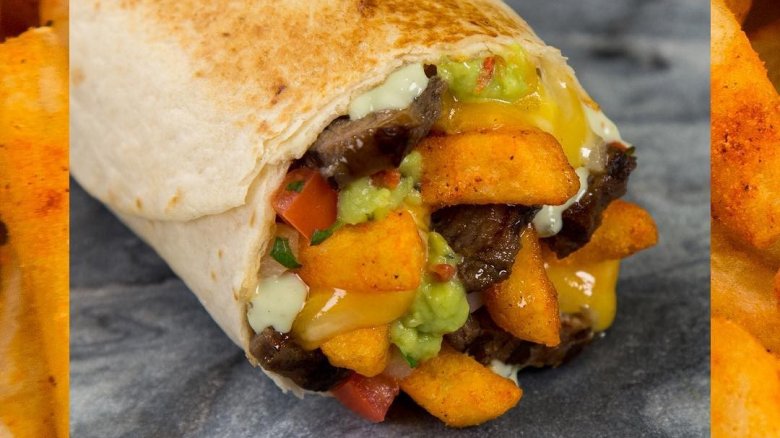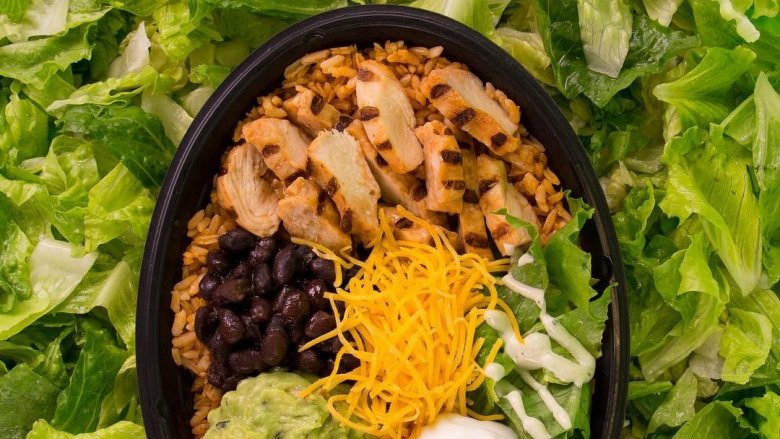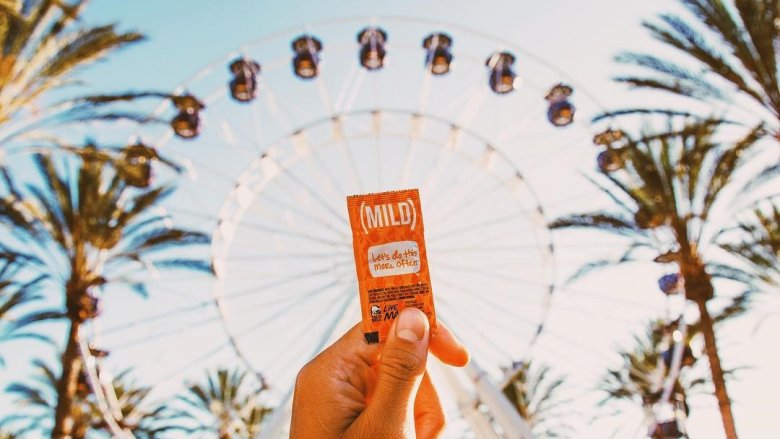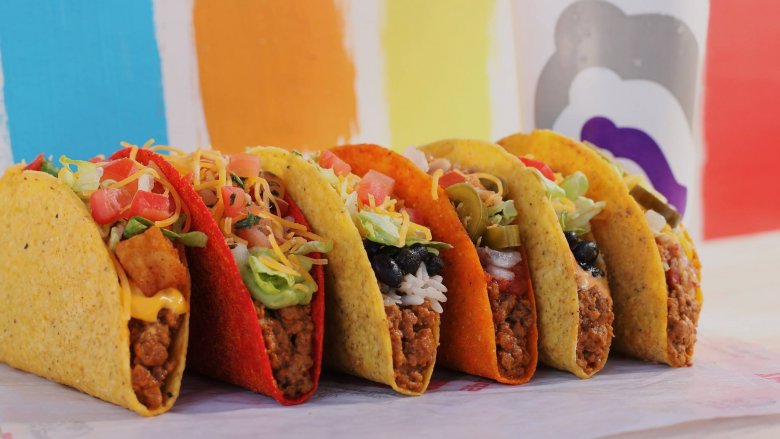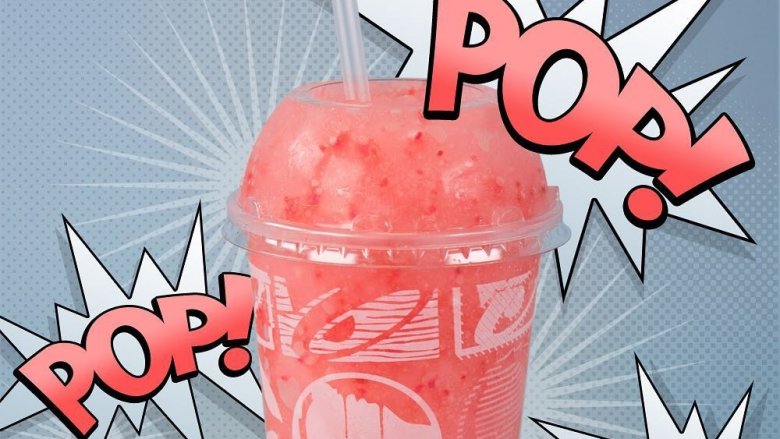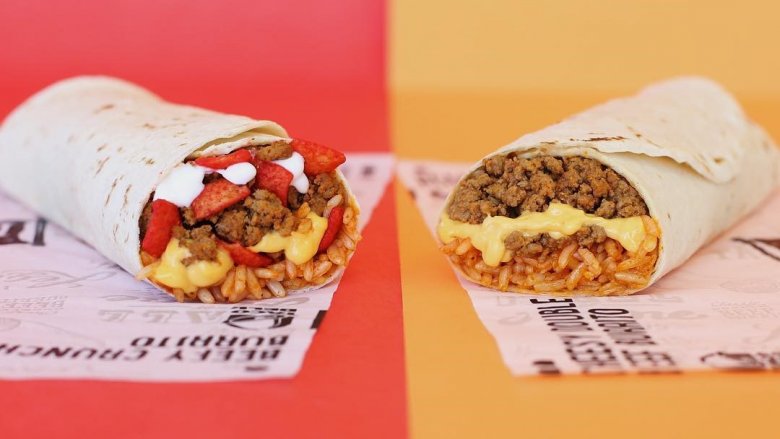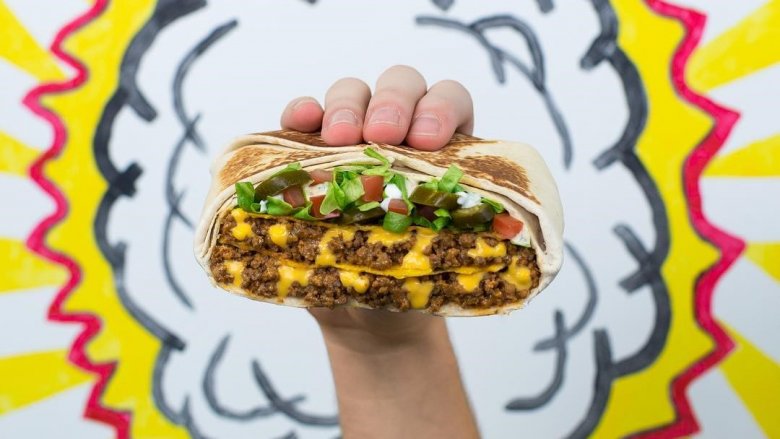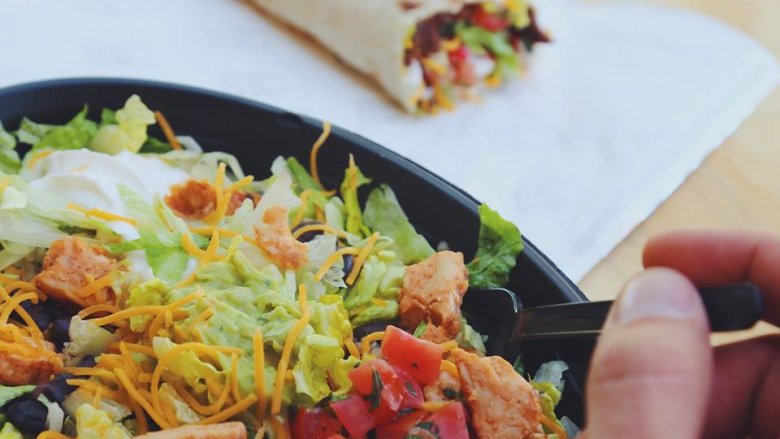What Taco Bell Doesn't Want You To Know About Their Ingredients
All fast food chains have their naysayers, but Taco Bell seems like it's more frequently a target than others. There are a ton of rumors out there about just what goes into those delicious, delicious tacos, and not all the rumors are good. So what's fact and what's fiction?
Before we get to the facts, let's talk about the fiction. One of the biggest rumors surrounding Taco Bell is that their seasoned beef isn't, well, beef. There are rumors it's Grade D beef, that it's worms, that it's super low-end... but none of that is actually true. We took a look at the whole story, start-to-finish, here, so we can definitely say Taco Bell's seasoned beef is actual beef, except for about 12 percent. That other stuff is seasonings (you season your taco meat at home, too, right?) and pretty standard food additives that adjust the color and texture to something people like.
And it works, because people don't just like Taco Bell, they love it. But will you still love it after we spill the refried beans about what they'd rather you didn't know?
The refried beans come in pellet-form
Ever notice that any time you get anything with those refried beans, it's a bit of a gamble? Sometimes they're way too dry, and you end up forcing them down with most of your drink. Sometimes they're way too watery, and they turn your burrito or nachos into a soupy mess. What gives?
It's because of the way they're prepared. They don't come in a typical bean form, according to one employee from the Reddit thread, "Current Taco Bell Employee. AMA." They come in sacks, dried, and in a form that makes them look a little bit like the pellets you might more commonly associate with rabbit food. Employees add water and mix to rehydrate them into beans, and that's why they're never the same consistency. The drier the beans, the longer they've been sitting out on the line. Skeptical? There are even YouTube videos out there that show how weird it is.
That steak is weird steak
There are a few behind-the-scenes secrets Taco Bell probably doesn't want you to know about one of their most expensive ingredients, and it's the one that Paste Magazine calls "steak." They say that places like Taco Bell get away with calling some of their meats "steak" because they're trying to capitalize on America's idealization of steak, but also point out that if you're getting steak for pennies on the dollar, it's probably only loosely called that.
Employees agree. When Eat This, Not That! looked to employees for advice on what not to order, steak was high on the list. They said if customers knew what steak starts to look like when it sits on the line for even a decently short amount of time, they'd definitely give it a miss. It's described as having the consistency of hair gel, and that's a way no food should ever be described. Even Paste noticed that when you look at the steak you're served, there's a higher "goo to meat" ratio going on there. So... no.
They might be leftovers
Waste not, want not... right? How far that extends to your favorite fast food chain is up for debate, but several employees and former employees on Reddit have warned customers to be wary of eating there first thing in the morning. The ingredients, they say, might be less-than-fresh.
One volunteers that in their experience it took about an hour after opening to get rid of all the ingredients leftover from the night before. That's hot and cold ingredients, and while in theory they're supposed to be properly packaged and refrigerated, that's not always the case. Another former employee noted that by the time closing time rolled around, the staff was just too tired to go through all the proper steps.
Another said that while most of the food was properly tended to if it was left over, there were some ingredients — like the steak and the chicken — that were such slow sells that in some locations, they might be carried over for days. For every horror story, there are others saying that their managers were sticklers for health and safety, though, but still. It's better to know.
The nutritional content of those sauce packets
Who doesn't love Taco Bell's sauces? It doesn't matter which one's your favorite (and devotes know it's not just a matter of heat, they have very, very different flavors, too), it's impossible to think of ordering without asking for some extra.
That sauce is definitely a crucial ingredient to anything on Taco Bell's menu, so here's a question: how many do you use? One or two on a taco? Three or four on a burrito? More? It adds up fast, right?
And here's the problem. While there's no fat in that little packet, there is a lot of sodium. According to SFGate, one mild sauce packet has 35 mg of sodium. If you use two on a taco and have three tacos for lunch, that's six packets and 210 mg of sodium. Now, consider that the American Heart Association recommends trying to keep your sodium intake under or around 1500 mg a day. You just spent a huge chunk of your daily allotment on those sauce packets alone!
The food's really high in sodium, too
Sauce packets aren't the only thing at Taco Bell that's hiding a ton of sodium. There's so much there that some items — like the Grande Scrambler Burritos, the XXL Grilled Stuft Burritos, and the Breakfast Crunchwraps — have your entire day's worth of sodium wrapped up in them. That's shocking, but what's more shocking is that's still the case after Taco Bell went on a very, very quiet campaign to lower the sodium in their menu items.
According to USA Today, Taco Bell had already lowered the sodium content of its ingredients by 15 percent between 2009 and 2015. That just makes you wonder how much sodium used to be in there.
They're not done yet, they say, and by 2020 parent company Yum! Brands wants 20 percent of their chains' menu items under the guidelines for mealtime limits. (Yum! owns Taco Bell, Pizza Hut, and KFC.)
Look at it this way. Eat three soft tacos, and you're getting 1500 mg of sodium right there — and that's without sauce.
The government once investigated their taco shells
This one's going back a bit, back far enough that Taco Bell is probably hoping you've forgotten about it. Taco Bell's grocery store line of products was brilliant for those of us that want to get our fix at home, but in September 2000, Purdue University says their taco shells were pulled from grocery store shelves. The problem? StarLink corn.
StarLink corn is a perfect example of just why GMOs get such a bad reputation. StarLink is a particular type of corn that contained a gene that made it deadly to a certain type of pest, the European corn borer. There were no other adverse reactions in any other species reported, and it was deemed 100 percent safe for livestock feed, but it hadn't been fully evaluated by the FDA for use in human food. (Of highest concern was the potential to cause allergic reactions.) But it still found its way into taco shells made in Mexico for Taco Bell, says ABC News.
Environmental activists went on a crusade, and even though the Center for Consumer Research reports it wasn't found to be dangerous, the Taco Bell shells were recalled.
That whole no artificial colors thing?
In 2015, Taco Bell made headlines when they became the latest chain to promise to get rid of artificial ingredients like food dyes. The biggest changes came with the nacho cheese, which lost yellow No. 6, and red tortilla chips that lost their red food dyes (via USA Today).
But take a look at their ingredients even years after their announcement, and you'll see that many of their drinks still come with things like red No. 40, and blue No. 1. What gives?
If you read between the lines of their announcement, you'll notice that it only applies to most of their items, not all. Their drinks will continue to contain artificial colors, and so will any of their co-branded items. Those are things like the Doritos tacos shells, and while the announcement covers about 95 percent of their menu items, they're probably hoping you'll overlook the fact that they weren't committed enough to go the whole way.
Their former CEO was clueless about the ingredients
Sure, a CEO is a businessman, not a chef or a nutritionist, and you can't expect them to know their way around a kitchen. But they should have a pretty thorough knowledge of their products, right? You'd hope, and what happened with former CEO Greg Creed is probably the scariest thing about that Taco Bell seasoned beef lawsuit that made headlines in 2011.
CBS News said Taco Bell's response to the lawsuit wasn't great, mostly because they had the CEO front and center going on about how all the ingredients in the meat where there for a reason... and unfortunately for him, someone asked him what that reason was. He was on Good Morning America when he was asked about something called an "isolated oat product," and he had to admit that he didn't know what it was or why it was there.
"I'm not a food scientist," he said. "But what I can tell you is that every ingredient is in there for a purpose."
All right... great? It's not encouraging when the high-ranking officers of a company can't be bothered to do the research to find out exactly why they use the ingredients they do.
They've dragged their feet toward ethical sourcing
Animal welfare and responsibly sourced and raised meats is a huge deal to a lot of people, but in 2015, The Washington Post outed Taco Bell (and sister companies Pizza Hut and KFC) for their lack of commitment on all fronts. They said that in 2014, then-CEO Greg Creed said it would be nice for Taco Bell to go hormone- and antibiotic-free, but that it just wasn't possible.
They also report that sure, it can be difficult to find responsible sourcing for products, but doesn't that say something about the scale of the problem? Humane farming methods are more expensive, they note, and that might also have something to do with why Taco Bell has been slow to get on the bandwagon that every decent person should seriously already be on.
According to Darren Tristano, a market research expert at Technomic, money is at the heart of Taco Bell's less-than-responsible ingredient sourcing. He says, "Taco Bell is at such a low price point, even for fast food, that [it's] really hard to switch to any sourcing that will affect price."
Is that acceptable?
Antibiotics with your tacos?
In 2016, Taco Bell issued an official statement saying they were going to stop using chicken raised with antibiotics. Chicken is a major ingredient, and they promised the switch was going to happen by 2017. Cynics might say it was about time, especially since they used a quote from the World Health Organization talking about how important it was to get antibiotics out of food. That quote was dated from 2013.
Every year, the country's fast food chains are given a report card score based on their ingredient sourcing and use of antibiotics. According to CNN, Taco Bell got a B- for their work toward antibiotic-free chicken, and that's great. But, that brings up a super-important question: What about all that beef? Taco Bell didn't answer CNN's request for more information on their ingredient sourcing, and that's worrisome. There are some things that should be completely transparent, and sourcing is one of them.
